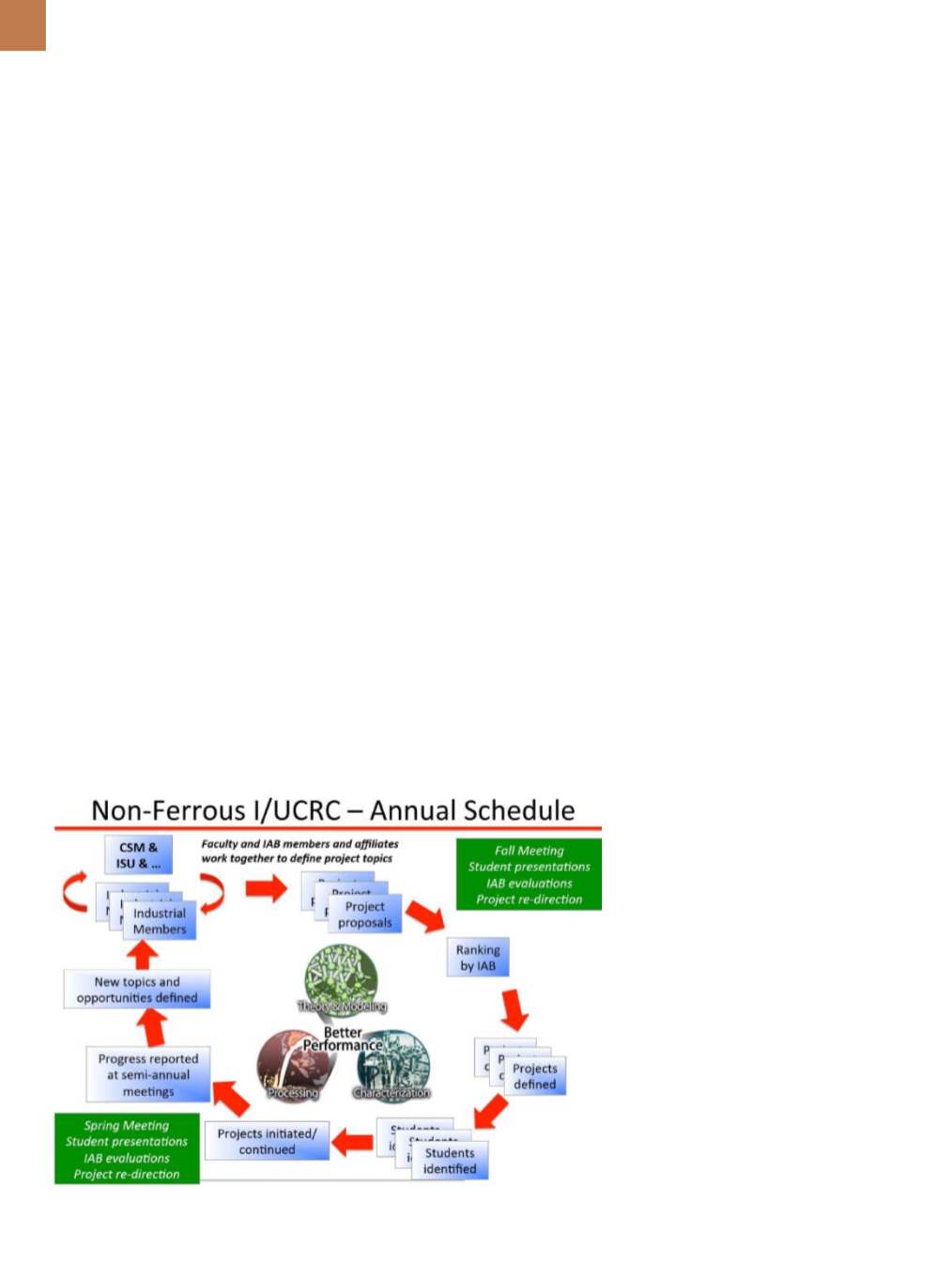

A D V A N C E D M A T E R I A L S & P R O C E S S E S | O C T O B E R 2 0 1 6
3 2
weight non-ferrous alloys, high per-
formance non-ferrous alloys, and
advanced alloys and processes. Current
project titles are listed in Table 1.
NEW PROJECT SELECTION
It is common for universities to
conduct research that is poorly aligned
with industry needs, largely because
faculty are unaware of the economic,
infrastructural, or pragmatic technical
requirements of industry. Thus, it is
imperative that members within a con-
sortium such as CANFSA play a pivotal
role in project definition, selection, and
execution. As shown in the schematic
in Fig. 2, CANFSA provides its mem-
bers with a number of opportunities to
influence the direction of center-funded
research projects, including setting
objectives, participating in strategic
planning, defining technology needs
by providing project ideas and propos-
als, and voting on projects that will be
undertaken.
CANFSA has developed a com-
prehensive, multimonth process for
selecting new projects, which it has
implemented during the past two years.
The procedure consists of the following
steps:
1. Ideas for new projects, including a
title and short description, are sub-
mitted by faculty and members.
2. Ideas are distributed to IAB mem-
bers who rate each topic, and the
list is then narrowed to the top
10-14.
3. Members and faculty then discuss
each of the ideas in a videoconfer-
ence. Ideas might be combined,
and if they are sufficiently vetted,
they will be carried forward.
4. During the videoconference, each
idea is assigned industrial and
faculty champions who produce
a project outline to be presented
at the fall IAB meeting.
5. At the IAB meeting, a structured
review process solicits further
input frommembers, who ulti-
mately vote to define project prior-
ity. Full members receive 30 votes
while associate members get 10
votes to distribute among different
projects.
6. Projects with the highest votes are
then selected as research topics
for incoming students depending
on available funding levels and
student interests.
Since implementing this process
in 2014, 81% of new projects selected
originated from ideas initially sug-
gested by member organizations—a
testament to themember-driven nature
of the center.
CENTER-MEMBER
COMMUNICATION
Formal communication between
universities and members is critical to
the success of CANFSA. This dialogue is
accomplished in several ways.
IAB meetings:
CANFSA hosts two
semi-annual IAB meetings where stu-
dents present research results. Typ-
ically, about 50 people attend these
meetings, which are invaluable for
providing personal interactions and
networking among participants. Orga-
nizations interested in joining CANFSA
are welcome to attend one IAB meeting
as a guest.
Videoconference series:
CANFSA
also hosts two videoconference series
per year—spaced between the semi-an-
nual IAB meetings. Accordingly, stu-
dents present project updates to
members four times per year. Videocon-
ferences provide an important oppor-
tunity for transferring information and
enable an essentially unlimited number
of employees from each member orga-
nization to access research results and
provide students with project guidance.
For example, one member organization
recently had more than 20 employees
from across multiple divisions in sev-
eral states participate in one or more of
the sessions.
Project mentoring:
Project men-
toring is another important com-
munication tool between students
and members. As such, at least one
“industrial mentor”
from a member
organization is identified for each
project. Industrial mentors frequently
interact with students and faculty
to provide industrial perspectives and
research guidance. Written guide-
lines help define the project mentor
role.
~AM&P
For more information:
Stephen Mid-
son is managing director, CANFSA, Col-
orado School of Mines, 1500 Illinois St.,
Golden, CO 80401, 303.868.9766, smid-
son@mines.edu. For more information
about CANFSA, email
canfsa@mines.edu, or visit canfsa.mines.edu.
Fig. 2 —
Operational practices for CANFSA.
















